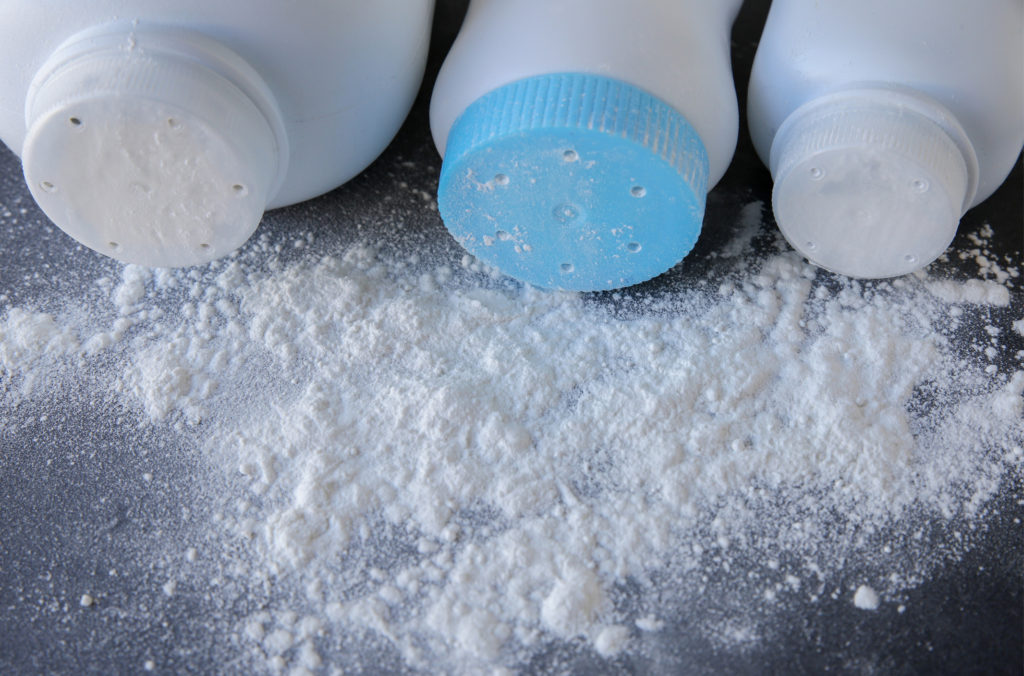
Recent trials have revealed that Johnson & Johnson long knew about the link between talcum powder and ovarian cancer. Newly released documents from a current trial in St. Louis, Missouri, suggest that the pharmaceutical giant also knew that the talc it used in its baby and body powder products contained asbestos, a known carcinogen.
The team representing 50-plus women in a talcum powder lawsuit against Johnson & Johnson released the bombshell information earlier this month, which claims the company knew decades ago that asbestos fibers were in its talc-based products. These new documents dispute previous claims and memos by Johnson & Johnson’s legal team that the company never found asbestos in its products “and it never will.”
Bloomberg News reported that as far back as the early 1970s there were company memos noting that traces of two different types of asbestos were found in the talc it obtained from a mine in Vermont. According to the report, the company also had a booklet from 1974 describing the asbestos-contaminated talc in a mine the company purchased in Italy.
This new evidence casts serious doubt on the pharmaceutical and consumer company, which has already been found liable in four cases. Thus far, Johnson & Johnson has had to shell out more than $700 million in damages to the many women who have been diagnosed and are suffering from ovarian cancer or, as some women have already passed away, their surviving family members.
The Link Between Asbestos, Talc & Ovarian Cancer
There are still many unknowns about talc’s exact part in ovarian cancer, but one fact is well known: asbestos is known to cause certain types of cancer—such as mesothelioma and cancers of the lung, colon, and throat—and contribute to the development of others.
Mesothelioma is almost always associated with an exposure to asbestos and is an aggressive form of cancer that typically affects the lungs and includes symptoms such as a cough, chest pain, and shortness of breath. While it usually develops in the lungs, it can also be found in the heart and abdomen. Mesothelioma can be treated—treatments include surgery, radiation, and chemotherapy—but the condition cannot be cured.
Asbestos is actually known as the number one cause of occupational cancer in the world because most people who develop mesothelioma do so from occupational exposure. Professionals most commonly associated with extreme asbestos exposure include mining, construction, heavy industry, shipbuilding, asbestos product manufacturing, firefighting, electricity generation, and military service. Because of second-hand exposure, family members of those working in these industries and those who live within a close vicinity of asbestos-contaminated mines or processing facilities are actually at a greater risk of developing an asbestos-related disease as well.
While it has become common knowledge that asbestos exposure leads to many deadly cancers and diseases, there really have been no real studies done on asbestos-contaminated talc. The main reason for that is because Johnson & Johnson has always claimed that its products containing talc were free of asbestos. The new revelations about the decades-old documentation about the link between asbestos and the talc used by Johnson & Johnson will most certainly reinforce the case brought against the pharmaceutical giant because it’s already known that asbestos does cause cancer.
Johnson & Johnson has already tried to get the class action lawsuit by the 50 women in St. Louis thrown out, but to no success—the federal judge dismissed their claims. The company has also chosen not to settle any suits brought against them so far, which could prove to be very expensive before it’s all said and done.
Have You Used Talcum Powder?
It has been commonplace for years for women to use talcum powder for general hygiene needs, even though Johnson & Johnson has known for decades that their talc was not asbestos-free. If you have used or currently use any talc-based products, it’s best to take action now to prevent any further exposure.
To start, stop using any talc products on or near your genitals. That also means don’t let it touch anything that gets anywhere near your genitals, such as undergarments, sanitary napkins, and tampons.
Second, early detection is key. Look for any potential symptoms that would suggest ovarian cancer. Talk with your doctor about potential signs or symptoms you discover.
If you have already been diagnosed with ovarian cancer and have used talc-based products, give us a call today so that we can talk you through your legal rights. You may be eligible for compensation.
BEGIN YOUR OVARIAN CANCER LEGAL BATTLE TODAY
If you were diagnosed with ovarian cancer after using talcum baby powder, you may qualify for compensation. Contact our experienced talc powder lawyers to get the help you deserve.
We know how difficult struggling with a cancer diagnosis can be. Insurance companies, expensive medical costs, and taking time off from work can add to the strain. Your total focus and attention should be on your recovery alone. Our team is dedicated to ensuring you receive the best possible care and compensation for your drug-related injuries.
The compassionate advocates at Cory Watson are ready to fight for you. Don’t wait to reach out – call (877) 562-0000 or fill out the consultation form on this page.